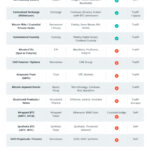In an exciting turn of events for the cryptocurrency market, U.S. spot Bitcoin ETFs have seen stunning net inflows totaling approximately $2.8 billion over just five trading days. This surge has contributed significantly to the price of Bitcoin, which has jumped from around $85,000 to a noteworthy $94,000. Leading the charge is the iShares Bitcoin Trust (IBIT), which has attracted $1.3 billion of these impressive inflows.
Michael Saylor, the Chairman of the largest publicly listed Bitcoin holder, MicroStrategy (MSTR), made compelling predictions during the Bitcoin Standard Corporation’s Investor Day. He stated, “IBIT will be the biggest ETF in the world in ten years,” drawing attention to its rapid growth. Currently, the IBIT boasts a market capitalization of $54 billion and saw over $1.5 billion in trading volume just recently. For context, the largest ETF by market capitalization, the Vanguard S&P 500 ETF (VOO), sits at a staggering $593.5 billion, highlighting the ambitious journey ahead for IBIT.
Eric Balchunas, a Senior ETF Analyst at Bloomberg, acknowledged the potential for IBIT to eclipse the VOO, but he remained cautious, noting the extraordinary conditions that would need to exist for this to happen. “It’s possible, especially if IBIT starts taking in more cash than VOO, but that would require inflows well north of $1 billion a day—more likely in the range of $3 to $4 billion daily, to gain ground,” explained Balchunas.
“In short, some extraordinary things would have to happen, but it’s possible,” he added, underscoring the exceptional nature of the current market dynamics.
In addition to these inflows, the annualized basis trade for Bitcoin ETFs has seen a rise to nearly 10%, up from 5% earlier in the year. This increase, along with a significant 2,000 Bitcoin surge in futures open interest over the past week, indicates that a portion of the ETF inflows may be tied to strategic trading, rather than simple bets on price direction.

Bitcoin ETFs and Market Impact
Recent developments in the U.S. cryptocurrency market, particularly concerning Bitcoin ETFs, have significant implications for investors and the broader financial landscape. Here are the key points:
- Net Inflows into Bitcoin ETFs:
- U.S. spot bitcoin ETFs have seen approximately $2.8 billion in net inflows over the last five trading days.
- This surge in investment has helped propel bitcoin’s price from around $85,000 to $94,000.
- Significant Contribution from iShares Bitcoin Trust (IBIT):
- IBIT has accounted for $1.3 billion of the recent inflows.
- IBIT currently holds a market capitalization of $54 billion.
- Market Potential and Future Predictions:
- Michael Saylor, Chairman of MicroStrategy, predicts IBIT could become the largest ETF in the world in ten years.
- However, this would require an extraordinary increase in inflows, potentially upwards of $3 to $4 billion daily.
- Comparative Market Dynamics:
- The largest ETF by market cap, the Vanguard S&P 500 ETF (VOO), has a market capitalization of $593.5 billion, which is more than ten times that of IBIT.
- Annualized Basis Trade Increase:
- The annualized basis trade for bitcoin ETFs has risen to nearly 10%, indicating growing investor confidence.
- This increase suggests that some net ETF inflows may involve strategic trading rather than purely directional bets.
Eric Balchunas from Bloomberg highlights the extraordinary nature of potential future ETF dynamics, acknowledging the challenges IBIT would face in overtaking VOO.
Bitcoin ETFs Surge as IBIT Attracts Record Inflows
The recent surge in net inflows into U.S. spot bitcoin ETFs, amounting to around $2.8 billion in just five trading days, reflects a significant moment in the cryptocurrency market. The iShares Bitcoin Trust (IBIT) has emerged as a frontrunner in this wave, accounting for a staggering $1.3 billion of these inflows. This bullish trend has propelled the price of Bitcoin from $85,000 to an impressive $94,000, sparking considerable excitement among investors and market analysts alike. Michael Saylor, Chairman of MicroStrategy and a prominent figure in the bitcoin community, boldly predicted that IBIT could potentially become the largest ETF globally within the next decade, a statement made during the Bitcoin Standard Corporation’s Investor Day event.
When weighed against traditional financial products, IBIT’s rapid growth raises important questions about its competitive advantages and potential drawbacks. For example, while the Vanguard S&P 500 ETF (VOO) currently leads with a market capitalization of $593.5 billion—over ten times that of IBIT—this significant gap in size could be seen as a double-edged sword. On one hand, IBIT’s smaller market cap allows for potentially greater volatility and faster growth trajectories, which can appeal to younger, risk-tolerant investors. Adding to this competitive edge, the recent rise in annualized basis trades for bitcoin ETFs indicates a growing sophistication among investors, suggesting that they are looking beyond simple price appreciation.
However, there are considerable challenges that could impede IBIT’s journey to dominance. The suggestion from Bloomberg analyst Eric Balchunas that IBIT would need to see daily inflows of $3 to $4 billion to realistically compete with VOO is a daunting target. Such extraordinary capital flows could strain market dynamics and create issues for liquidity that might deter both retail and institutional investors worried about volatility. Additionally, while the recent net inflows are promising, there’s a risk that they could taper off, especially if macroeconomic conditions shift or if regulatory challenges arise within the cryptocurrency space.
The landscape of investment is likely to benefit various stakeholders from this escalating competition. Retail investors looking for high-risk, high-reward options may gravitate toward bitcoin ETFs for the potential returns. Conversely, traditional investors might experience turmoil as crypto assets inch closer to mainstream acceptance, prompting them to reconsider their strategies. Ultimately, while IBIT represents an exciting opportunity for adventurous investors, its unprecedented pace could introduce volatility that creates uncertainty for conservative financial portfolios.
















